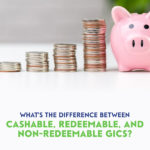Cashable GICs vs. Redeemable GICs vs. Non-Redeemable GICs – What’s the Difference?

Guaranteed investment certificates or GICs are some of the safest investments. Unlike investing in stocks in the stock market, your principal is always guaranteed a GIC (hence the name). Because GICs are treated like deposit or savings accounts, the CDIC (Canadian Deposit Insurance Corporation protects balances up to $100,000.
You can invest in a GIC in a taxable or registered account (such as an RRSP, TFSA, RESP).
But not all guaranteed investment certificates are the same. There are some critical differences between cashable GICs, redeemable GICs, and Non-Redeemable GICs. Knowing the difference and pros and cons of each can help you choose the right product for your financial situation.
What Is a Cashable GIC?
A cashable GIC has some of the most flexible redemption terms. When you deposit your money into a cashable guaranteed investment certificate, there is typically a waiting period of 30-90 days. After the waiting period, you can withdraw your cash anytime without penalty.
Most cashable GICs have a 1-year term, but that is more of a general guideline than a firm maturity date. If you choose to cash out your funds before maturity, you will only earn the total interest rate for the investment period (think of it as a prorated amount).
Some cashable products may have minimum redemption and balance amounts, limiting the amount you can withdraw or are required to invest. But they can be beneficial in a changing rate environment. If you notice that rates are increasing, you can cash out your funds and reinvest them at a higher rate.
Due to the increased flexibility of cashable GICs, they typically have lower interest rates than other types of guaranteed investment certificates.
What Is a Redeemable GIC?
A redeemable GIC is slightly more flexible than cashable products, but that flexibility comes with an early redemption penalty.
Typically redeemable GICs have maturities that are longer than one year. But with a redeemable product, you can cash it in at any time after purchase. There is no waiting period.
Where redeemable and cashable GICs differ is in their interest rates. With a redeemable GIC, you will be subject to an early redemption schedule (or penalty) if you pull out your money before the end of the term. An early withdrawal means your funds earn a lower interest rate than a full-term investment. Whereas with a cashable GIC, the interest earned is a consistent prorated amount.
What Is a Non-Redeemable GIC?
A non-redeemable GIC is the least flexible product and therefore has some of the highest relative interest rates. With a non-redeemable GIC, your money must stay invested for the full term. If you were to withdraw your cash early, there would be no interest earned, and in some cases, you may have to also pay a fee for breaking the term.
Although this type of investment often has some of the strictest terms compared to other options, they offer a guaranteed return for a set period. Terms for non-redeemable guaranteed investment certificates are usually anywhere from 3 months to 10 years. The longer the term, typically the higher the interest rate you earn.
Non-redeemable GICs are very low-risk, reliable investments. Their rates may be as much as 1-2% higher than other GIC rates. Payment frequencies can also differ with non-redeemable GICs. Check with your bank before investing because your interest may be paid out monthly, bi-annually, annually, or at the end of the term.
Some non-redeemable GICs have a minimum investment required, and some may automatically renew. It’s essential to check out the terms of any product before investing.
Cashable GICs vs. Redeemable GICs vs. Non-Redeemable GICs – Pros and Cons
| GIC | PROS | CONS |
Cashable |
|
|
Redeemable |
|
|
Non-Redeemable |
|
|
How to Choose a GIC
The safety of a GIC can be very appealing, but the lower rate of return puts your money at the risk of inflation. If your investment is not earning as much as the inflation rate, your money loses purchasing power.
So, before you decide to dump your life savings into a GIC, consider if it is even a suitable investment for you.
In some circumstances (when rates are decreasing), a cashable GIC is a better place to park your money than a high-interest savings account. And in other circumstances, a cashable product may be a better place to park your money than a regular savings account or everyday chequing account.
When considering what type of GIC to invest in, you will have to decide if access to your money or interest rate is more important. Suppose access is a priority, then a redeemable GIC maybe your best option. But if you are looking for the best return on your money, then a non-redeemable GIC may be the right choice. Just make sure to shop around to get the best rate you can.
And with whatever type of GIC you choose, make sure always to read the fine print first.
What one financial institution has as terms for its GICs can be drastically different from another bank. Some banks use cashable and redeemable GICs interchangeably, even though they do have subtle differences.
Depending on what you are looking for, the cashable GICs vs. redeemable GICs vs. non-redeemable GICs decision is an easy one to make. That is, as long as you understand the difference between each product.

